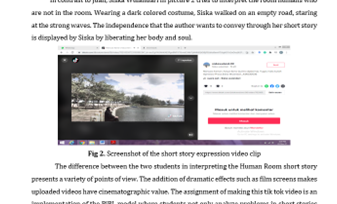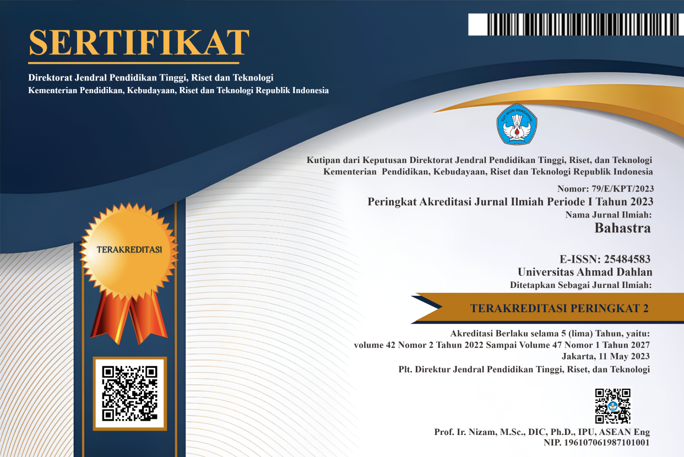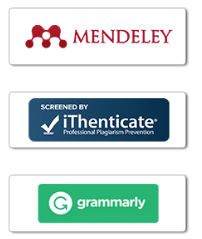Implementation of the PjBL learning model assisted by the TikTok application in the literary expression course
DOI:
https://doi.org/10.26555/bs.v42i2.76Keywords:
PjBL, TikTok App, Literary ExpressionAbstract
This study aims to improve the learning quality of the Literary Expression course using the TikTok application as a learning medium in the application of the PjBL model to the seventh semester students of the Indonesian Language Education Study Program FKIP Bengkulu University. The assignment of making this TikTok video is an implementation of the PjBL model where students not only perform analysis but also explore, collect information, interpret, and assess. This research was conducted in two cycles. The results of this study indicate that the use of the TikTok application as a learning medium in the application of the PjBL model can improve student learning outcomes. The achievement targets were obtained in cycle II with the following details: 15 students or 42% got category A, 17 students or 47% got category B, 4 students or 11% got category C, and none or 0 students got category D. The results of the response questionnaire showed a final score of 24 .61 or obtained an average of 4.1 which means that the category most chosen by students is agree. These results indicate that the implementation of the project assignment of making short stories expressing videos using the TikTok application is of interest to students. Not only reaching aspects of knowledge implementation but also increasing students' creativity and interest in learning activities.
References
Adawiyah, D. P. R. (2020). Pengaruh penggunaan aplikasi tiktok terhadap kepercayaan diri remaja di kabupaten sampang. Jurnal Komunikasi. 14 (2), 135-148. Doi: 10.21107/komunikasi.
Aji, W. N., & Setiyadi, D. B. P. (2020). Aplikasi TikTok sebagai media pembelajaran keterampilan bersastra. Metafora: Jurnal Pembelajaran Bahasa dan Sastra, 6(2), 147-157. https://jurnalnasional.ump.ac.id/index.php/METAFORA/article/view/7824.
Arsyad, A. (2009). Media pembelajaran. Rajawali Pers.
Enayati, F., & Abbas P. G. (2020). The impact of Computer Assisted Language Learning (CALL) on improving intermediate EFL learners vocabulary learning. International Journal of Language Education, 4(2), 96. Doi: 10.26858/ijole.v4i2.10560.
Bohang, F. K. (2018). TikTok punya 10 juta pengguna aktif di Indonesia Kompas.com. Retrieved September 10, 2018, from https://tekno.kompas.com/read/2018/07/05/09531027/tik-tok-punya-10.
Fitriana, R. W., Isnarto, & Prabowo, A. (2018). The analysis of student’s mathematical communication ability viewed from learning styles through project based learning models on cylinder and cone materials A R T I C L E I N F O. Unnes Journal of Mathematics Education, 7(3), 156–163. Doi: 10.15294/ujme.v7i1.22165.
Hansson, et.al. (2020). Book talks as an approach to nature of science teaching in early childhood education early childhood education. International Journal of Science Education, 42(12), 1–17. Doi: 10.1080/09500693.2020.1812011.
Imron, R. M. (2018). TikTok jadi aplikasi terbaik di play store. https://inet.detik.com/mobileapps/d4329137/tiktok-jadi-aplikasiterbaik-di-play-store.
Joyce, B. & Weil, M. (1982). Model of teachings. Prentice-Hall, Inc.
Kustandi, et.al.( 2011). Media pembelajaran; Manual dan Digital. Ghalia Indonesia.
Koehler, M. J., Mishra, P., & Cain, W. (2013). What is Technological Pedagogical Content Knowledge (TPACK)? Journal of Education, 193(3), 13–19. Doi: 10.1177/002205741319300303.
Mana, L. H. A. (2021). Respon siswa terhadap aplikasi tiktok sebagai media pembelajaran bahasa Indonesia. Jurnal inovasi dan Riset Akademik. Doi: 10.47387/jira.v2i4.107.
Nandiana, V., Jaelani, A., & Afiyattena, N. (2021). Promoting students’ confidence through video project-based learning. Journal of English Language Learning, 5(2), 87–94. Doi: 10.31949/jell.v5i2.3374.
Prabowo, A. (2012). Pembelajaran berbasis proyek untuk meningkatkan pemahaman mahasiswa atas permasalahan statistika pada perkuliahan studi kasus dan seminar. Kreano, Jurnal Matematika Kreatif-Inovatif, 3(2), 82–90. Doi: 10.15294/kreano.v3i2.2615.
Rasyid, M. H. (2020). Pembelajaran puisi secara daring dengan media pembelajaran berbasis aplikasi (TikTok) Kelas X SMA Negeri 3 Pati. Prosiding Seminar Nasional Pascasarjana (PROSNAMPAS), 3(1), 352-358. https://proceeding.unnes.ac.id/index.php/snpasca/article/view/584.
Rusman. (2008). Manajemen kurikulum (seri manajemen sekolah bermutu). Mulia Mandiri Press.
Siwa, I. B., Muderawan, I. W., & Tika, I. N. (2013). Pengaruh pembelajaran berbasis proyek dalam pemebalajaran kimia terhadap keterampilan proses sains ditinjau dari gaya kognitif siswa. E-Journal Program Pascasarjana Universitas Pendidikan Ganesha, 3(3), 1–13. https://ejournal-pasca.undiksha.ac.id/index.php/jurnal_ipa/article/view/794.
Susanto, A. (2012). Teori belajar dan pembelajaran di Sekolah Dasar. Kencana Prenada Media Group.
Sulisworo, D. (2016). The contribution of the education system quality to improve the nation’s competitiveness of Indonesia. Journal of Educationand Learning (EduLearn), 10(2), 127. Doi: 10.11591/edulearn.v10i2.3468.
Widyantini, T. (2014). Penerapan model project based learning dalam materi pola bilangan kelas VII. Pusat Pengembangan dan Pemerdayaan Pendidikan dan Tenaga Kependidikan (PPPPTK) Matematika, 1 (3), 2-19 http://p4tkmatematika.kemdikbud.go.id/artikel/author/publikasi/.
Yusuf, K. M. (2021). Exploring the Perspectives of Pre-University Students on Authentic Collaborative Writing Project. International Journal of Academic Research in Business and Social Sciences, 11(14), 199–210. Doi: 10.6007/ijarbss/v11-i14/8567.

Downloads
Published
Issue
Section
License
Copyright (c) 2022 Fina Hiasa, Emi Agustina, Ku-Ares Tawandorloh

This work is licensed under a Creative Commons Attribution-ShareAlike 4.0 International License.

1.jpg)






